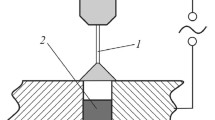Conclusions
The Nichrome alloy was alloyed with niobium to produce the materials of the LNKhB7 and LNKhB8 grades with a heterogeneous structure which consist of an alloyed solid solution and nickel and a high-hardness phase, i.e., molybdenum carbide. Heat treatment (normalizing, aging) greatly hardens the material as a result of the formation of the high-hardnessγ′ phase (Ni3Al).
The materials hardened with the high-hardness molybdenum carbide and theγ′ phase have high and stable strength properties in the temperature range 20–700°C (800°C); at temperatures higher than the temperature of hardening heat treatment the strength properties of the materials rapidly decrease.
Alloying the grade LNKhB materials with niobium greatly improves the tribotechnical characteristics as a result of the formation of a surface film in the form of complex compounds on the friction surfaces.
Similar content being viewed by others
Literature cited
I. D. Radomysel'skii, G. G. L'vova, and N. E. Ponomarenko, “Examination of the friction characteristics of an alloy with the nickel-chrome base (LNKh) at room temperature,” Poroshk. Metall., No. 11, 52–54 (1978).
I. D. Radomysel'skii, G. G. L'vova, and N. E. Ponomarenko, “Effect of elevated temperatures on the friction characteristics of an alloy with the nickel-chrome base (LNKh),” Poroshk. Metall., No. 12, 66–68 (1978).
I. D. Radomysel'skii, S. E. Kondratyuk, and G. G. L'vova, “Examination of the nature of failure of the material with the nickel-chrome base in the conditions of elevated temperatures,” Poroshk. Metall., No. 6, 63–68 (1979).
F. F. Khimushin, Creep Resisting Steels and Alloys [in Russian], Metallurgiya, Moscow (1969).
S. S. Gorelik, L. N. Rastorguev, and Yu. A. Skakov, X-Ray Diffraction and Electron Optical Analysis [in Russian], Metallurgiya, Moscow (1970).
M. V. Zakharov and A. M. Zakharov, Creep Resisting Alloys [in Russian] Metallurgiya, Moscow (1972).
Yu. G. Tkachenko, I. N. Gorbatov, and D. Z. Yurchenko, “Friction and wear of refractory carbides at high temperatures in air,” Probl. Treniya Iznashivaniya, No. 14, 42–46 (1978).
Author information
Authors and Affiliations
Additional information
Translated from Poroshkovaya Metallurgiya, No. 7(283), pp. 74–77, July, 1986.
Rights and permissions
About this article
Cite this article
Radomysel'skii, I.D., L'vova, G.G., Mamonova, A.A. et al. Effect of heat treatment on the strength and tribotechnical properties of material of LNKhB grade. Powder Metall Met Ceram 25, 594–597 (1986). https://doi.org/10.1007/BF00792370
Received:
Issue Date:
DOI: https://doi.org/10.1007/BF00792370




